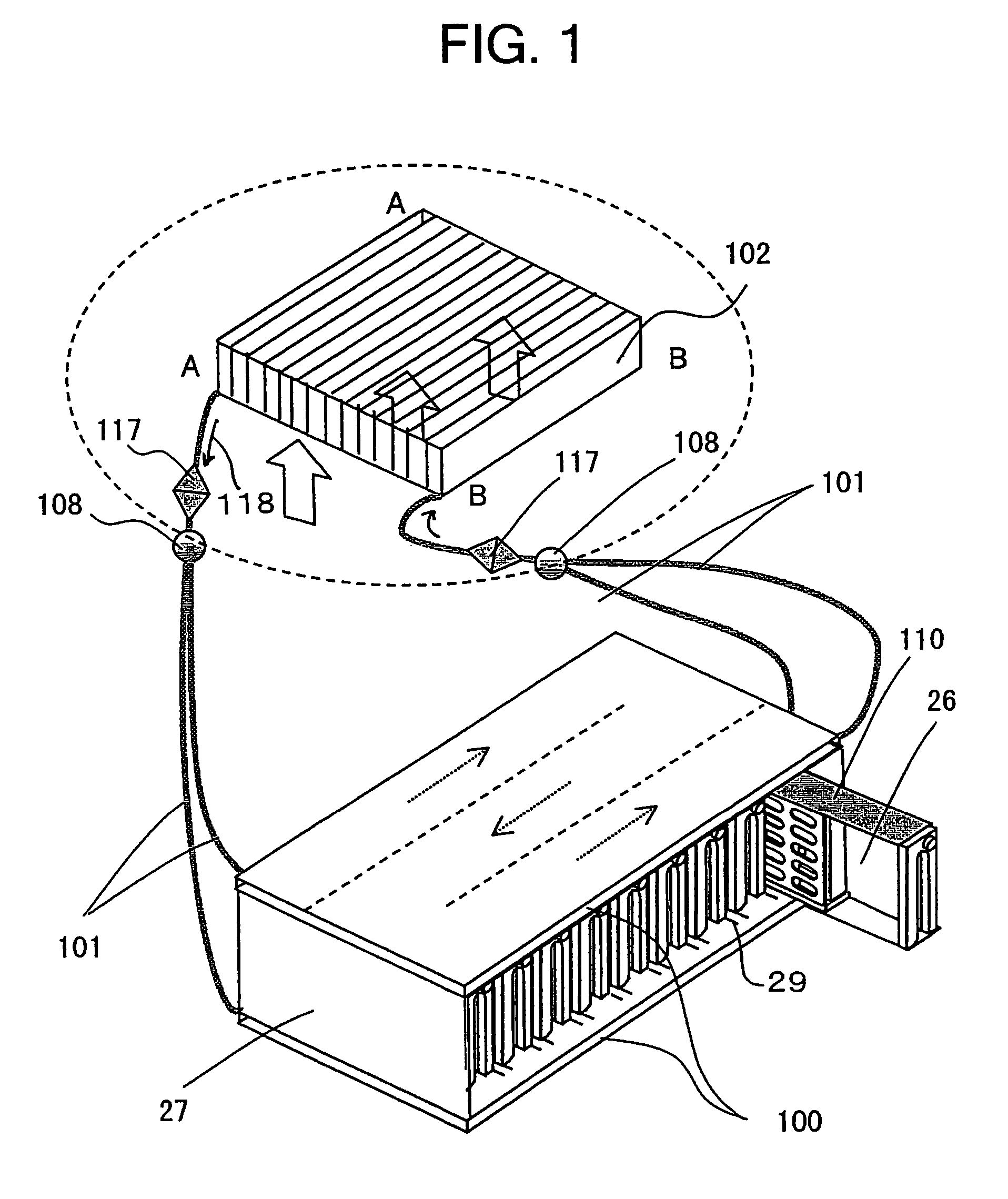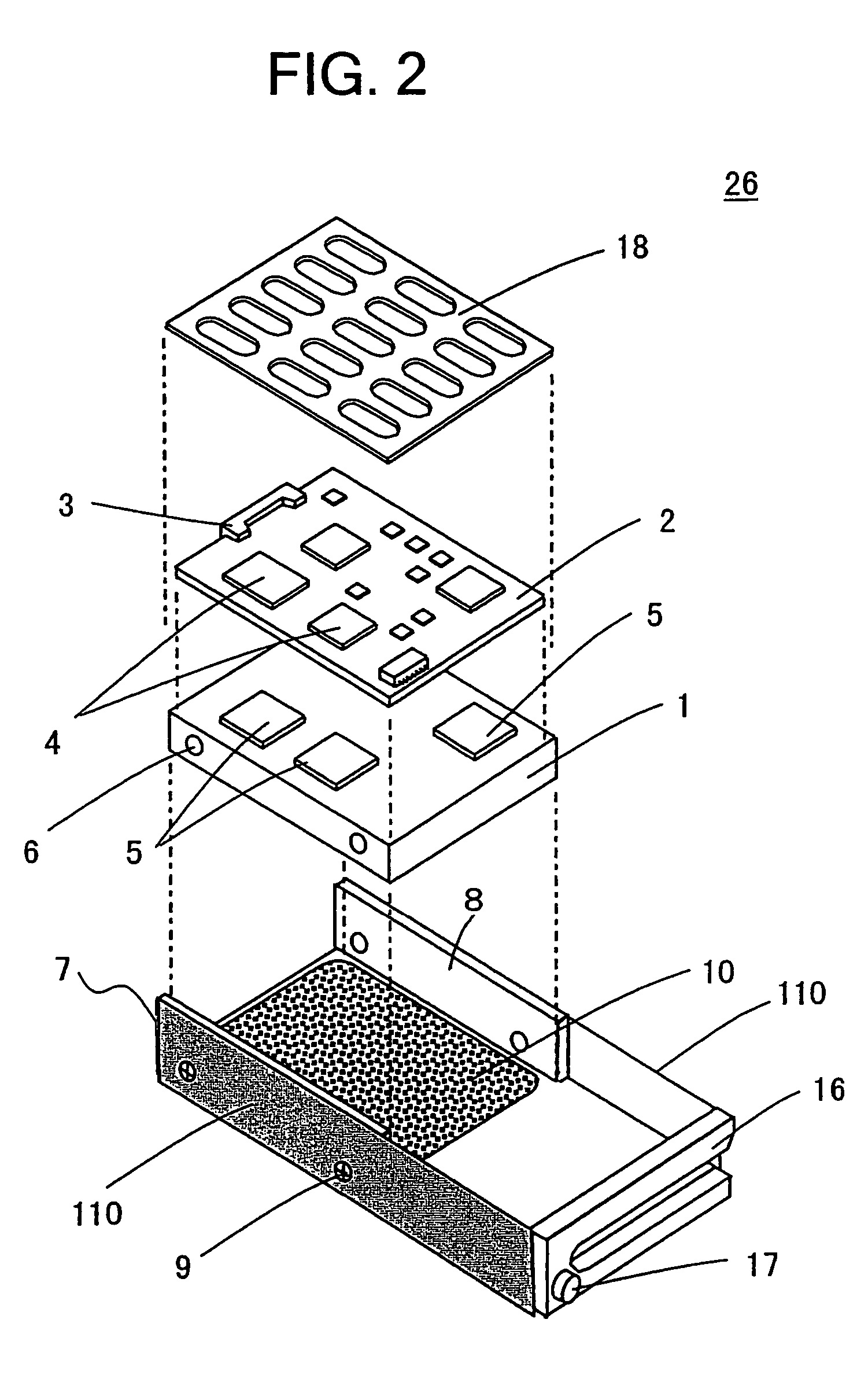Disk array system
a disk array and disk technology, applied in the field of disk array systems, can solve the problems of low long-term reliability of the disk array system, operational malfunction, and disk drive malfunction in the device constituting the disk drive, and achieve the effect of effectively cooling the densely packed disk driv
- Summary
- Abstract
- Description
- Claims
- Application Information
AI Technical Summary
Benefits of technology
Problems solved by technology
Method used
Image
Examples
first embodiment
[0038]A first embodiment of the present invention will now be described by referring to FIGS. 1 and 2. FIG. 1 is a perspective view of a disk array system according to the first embodiment. FIG. 2 is an exploded view of a disk drive according to the first embodiment. Referring to FIG. 2, a disk drive 26 includes a disk body 1, a control board 2, a cover 18 for covering the control board 2, and a housing 7. The disk body 1, the control board 2, and the cover 18 are assembled in this order and accommodated in the box-shaped housing 7. Although not illustrated in the drawing, the disk body 1 contains, in a thin case composed of a thermally-conductive material, a magnetic disk, a motor for rotating the magnetic disk, a read / write head for recording information onto the magnetic disk and for reproducing information recorded on the magnetic disk, and an actuator for driving the read / write head, for example.
[0039]The control board 2 disposed on the disk body 1 includes controlling circuits...
second embodiment
[0053]FIG. 3 is a perspective view of a housing 7 in a disk array system according to a second embodiment of the present invention. The disk array system of the second embodiment is different from that of the first embodiment shown in FIG. 2 in that projecting strips 112 having triangular cross-sections are disposed on the side surfaces of the housing 7 so as to extend in the longitudinal direction of the housing 7, in place of the heat-transfer-accelerating units 110 of the first embodiment. In the unit box 27, grooves (not shown) are disposed so as to correspond to the projecting strips 112. Accordingly, the housings 7 and the unit box 27 are connected over a sufficiently large contacting area, thereby accelerating the thermal transfer. Moreover, when thermally-conductive grease is applied to the surfaces of the projecting strips 112, thermal transfer is even further accelerated. The projecting strips 112 may also function as guide rails when the housings 7 are inserted into the u...
third embodiment
[0054]FIG. 4 is a perspective view of a housing 7 in a disk array system according to a third embodiment. In FIG. 4, the housing 7 is upside down with the bottom surface facing up. The disk array system of the third embodiment is different from that of the first embodiment shown in FIG. 2 in that guide rails 20 including protruding strips are disposed on one side surface of the housing 7 and a heat-transfer-accelerating unit 110 composed of thermally-conductive rubber is disposed on the surfaces of the protruding strips. The guide rails 20 facilitate positioning of the disk drive 26 when the disk drive 26 is inserted into or removed from the unit box 27.
[0055]According to the disk array system of the third embodiment, a plurality of spring clamps 113 is disposed on the other side surface of the housing 7 that opposes the side surface having the guide rails 20, and heat-transfer-accelerating units 110 to which thermally-conductive rubber is attached are disposed on the surfaces of th...
PUM
 Login to View More
Login to View More Abstract
Description
Claims
Application Information
 Login to View More
Login to View More - R&D
- Intellectual Property
- Life Sciences
- Materials
- Tech Scout
- Unparalleled Data Quality
- Higher Quality Content
- 60% Fewer Hallucinations
Browse by: Latest US Patents, China's latest patents, Technical Efficacy Thesaurus, Application Domain, Technology Topic, Popular Technical Reports.
© 2025 PatSnap. All rights reserved.Legal|Privacy policy|Modern Slavery Act Transparency Statement|Sitemap|About US| Contact US: help@patsnap.com



